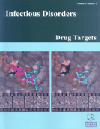- Home
- A-Z Publications
- Infectious Disorders - Drug Targets (Formerly Current Drug Targets - Infectious Disorders)
- Previous Issues
- Volume 10, Issue 2, 2010
Infectious Disorders - Drug Targets (Formerly Current Drug Targets - Infectious Disorders) - Volume 10, Issue 2, 2010
Volume 10, Issue 2, 2010
-
-
Editorial [ Hot Topic:Stroke Bugs: Current and Emerging Concepts Relevant to Infection in Cerebrovascular Disease] (Guest Editors: Hedley CA Emsley and Angel Chamorro)
More LessAuthors: Hedley C. Emsley and Angel ChamorroIn this fascinating special topic issue, contributors from various centres in the UK, Europe and the US have reviewed a range of subjects on the theme of infection and stroke. What is perhaps most surprising is that relatively little attention has been devoted to such a clinically important topic until very recently. The relationships between infection and stroke are wide ranging, as illustrated by the diversity of topics covered in thi Read More
-
-
-
Rashes, Sniffles, and Stroke: A Role for Infection in Ischemic Stroke of Childhood
More LessAuthors: Catherine Amlie-Lefond and Heather J. FullertonMajor infections-sepsis, meningitis, encephalitis-have long been recognized as causes of pediatric arterial ischemic stroke. However, minor infections may also contribute to the pathogenesis of stroke, either by causing a systemic prothrombotic state or direct or indirect vascular injury. A focal cerebral arteriopathy has been identified in a large proportion of otherwise healthy children present with a first ischemic stroke. Bo Read More
-
-
-
Human Immunodeficiency Virus (HIV) and Stroke: Targets for Intervention
More LessBy Myles ConnorHuman immunodeficiency virus (HIV) infection causes stroke through several mechanisms. Stroke results from opportunistic infection and neoplasia, HIV induced cardiac disease, HIV associated cerebral vasculopathy, and perhaps by HIV induced facilitation of some forms of systemic vasculitis and prothrombotic haematological conditions. HIV causes more ischaemic stroke than cerebral haemorrhage. Although stroke Read More
-
-
-
Infectious Burden: A New Risk Factor and Treatment Target for Atherosclerosis
More LessAtherosclerosis is a chronic inflammatory process, and several common bacterial and viral infections have been hypothesized to contribute to the inflammation of the vascular wall that leads to atherosclerosis. More recently, investigators have found preliminary evidence that the aggregate burden of these chronic infections, rather than any single organism, may contribute to atherosclerosis and risk of clinical vascular event Read More
-
-
-
Post-Stroke Immunodepression and Infection: An Emerging Concept
More LessAuthors: Hedley C. A. Emsley and Stephen J. HopkinsInfections occur commonly following stroke and adversely influence outcome. Dysphagia, greater stroke severity and increasing age are associated with post-stroke infection, but post-stroke immunodepression is now recognised as an independent factor associated with increased susceptibility. Counter-regulatory responses, triggered by the proinflammatory response to stroke, appear to effect systemic immunodepression via su Read More
-
-
-
Models of Infection Before and After Stroke: Investigating New Targets
More LessAuthors: Odilo Engel and Andreas MeiselInfectious diseases are the most common medical complication after cerebral ischemia, inpairing both the neurological and the general medical outcome. The most frequent infectious complications are bacterial pneumonia and urinary tract infections. There is a growing body of evidence that a secondary immunosuppressive state accounts for the increased risk of infection following stroke. Infections do not only have an i Read More
-
-
-
Virus Vasculopathy and Stroke: An Under-Recognized Cause and Treatment Target
More LessAuthors: M. A. Nagel, R. Mahalingam, R. J. Cohrs and D. GildenWhile arteriosclerotic disease and hypertension, with or without diabetes, are the most common causes of stroke, viruses may also produce transient ischemic attacks and stroke. The three most-well studied viruses in this respect are varicella zoster virus (VZV), cytomegalovirus (CMV) and human immunodeficiency virus (HIV), all of which are potentially treatable with antiviral agents. Productive VZV infection in cerebral Read More
-
-
-
Current and Emerging Treatments for Acute Stroke: Relationships with Infection
More LessAuthors: Craig J. Smith and Pippa J. TyrrellInfection is the commonest complication of stroke and has a major impact on morbidity and mortality. The relationships between susceptibility to infection after stroke and the influence of infection on stroke outcome are complex, but have considerable clinical relevance. Both pharmacological and non-pharmacological interventions in acute stroke may affect the risk of developing infection by influencing potentially modifiable ri Read More
-
-
-
Influenza and Stroke Risk: A Key Target Not to be Missed?
More LessAuthors: Christian Urbanek, Frederick Palm and Armin J. GrauThere is increasing evidence that acute bacterial and viral infection represent trigger factors that temporarily elevate the risk of ischemic stroke. During and after influenza epidemics vascular death rates and hospitalizations for stroke are increased. Influenza vaccination is an effective measure to reduce hospitalization and mortality in the elderly and work incapacity in adults of working age. Results of several observatio Read More
-
Volumes & issues
-
Volume 25 (2025)
-
Volume 24 (2024)
-
Volume 23 (2023)
-
Volume 22 (2022)
-
Volume 21 (2021)
-
Volume 20 (2020)
-
Volume 19 (2019)
-
Volume 18 (2018)
-
Volume 17 (2017)
-
Volume 16 (2016)
-
Volume 15 (2015)
-
Volume 14 (2014)
-
Volume 13 (2013)
-
Volume 12 (2012)
-
Volume 11 (2011)
-
Volume 10 (2010)
-
Volume 9 (2009)
-
Volume 8 (2008)
-
Volume 7 (2007)
-
Volume 6 (2006)
Most Read This Month
Article
content/journals/iddt
Journal
10
5
false
en


